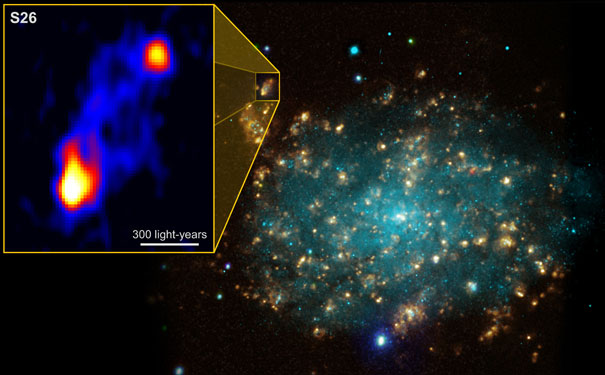
A composite image showing the position of the 'miniature galaxy' S26 in the galaxy NGC 7793. Image: Soria et al / CSIRO / ATCA; NGC 7793 – NASA, ESO and NOAO
A galaxy found nestled within another galaxy has led astronomers to conclude that black holes are much more powerful than previously believed.
An international team of astronomers, led by Dr Manfred Pakull at the University of Strasbourg (France) has discovered a microquasar contained inside a larger galaxy, NGC 7793, 13 million light-years away in the southern constellation of Sculptor. The microquasar, designated S26, is a small black hole weighing approximately the same as a small star.
S26 was observed earlier this year by Pakull and his team, using optical and X-ray telescopes (the European Southern Observatory’s Very Large Telescope and NASA’s Chandra space telescope). New observations using the CSIRO Compact Array radio telescope near Narrabri (NSW) has shown S26 to be an analogue of “˜radio galaxies’ and “˜radio quasars’.
Radio galaxies and quasars are believed to have dominated the Universe billions of years ago, but are nearly extinct today. They contain large black holes, which emit radio jets that can stretch for millions of light years.
Astronomers have been studying these for decades to understand how these jets form and whether the energy released could affect star formation. According to Roberto Soria from University College in London, UK, these are usually very difficult to measure.
S26 has provided scientists with an opportunity to study a “˜bonsai radio quasar’ and determine how much of the energy went into heating the surrounding gas or creating jet glow. They have concluded that only a thousandth of the energy released created the radio glow observed, suggesting that black holes are a thousand times more powerful than previously believed.
Dr Tasso Tzioumis of CSIRO Astronomy and Space Science. Stated in the press release “that means that black hole jets can be both more powerful and more efficient than we thought, and that their heating effect on the galaxies they live in can be stronger.”






